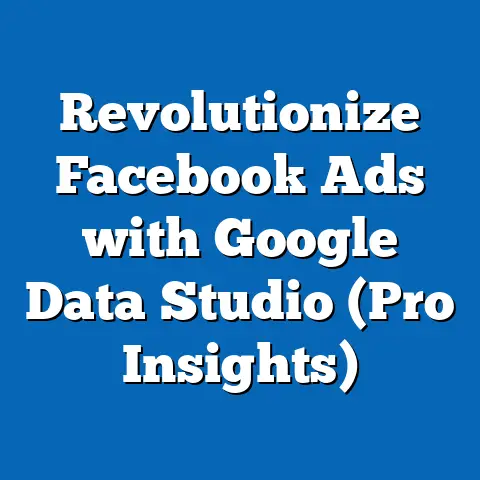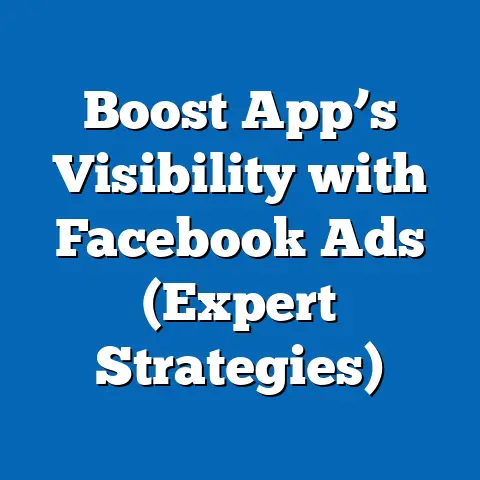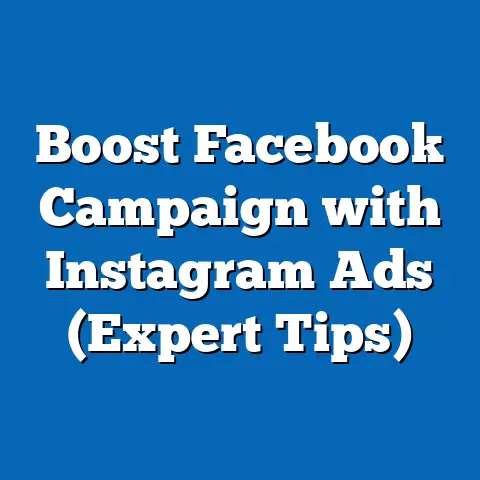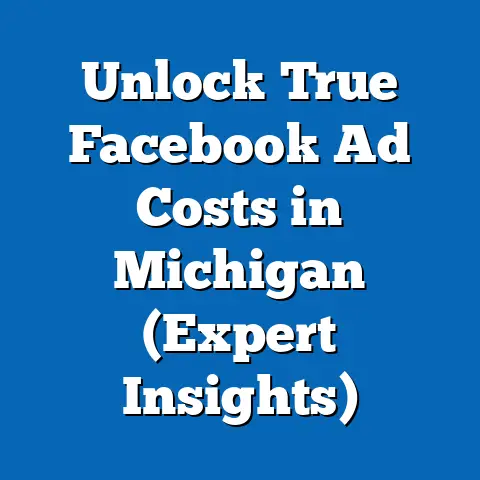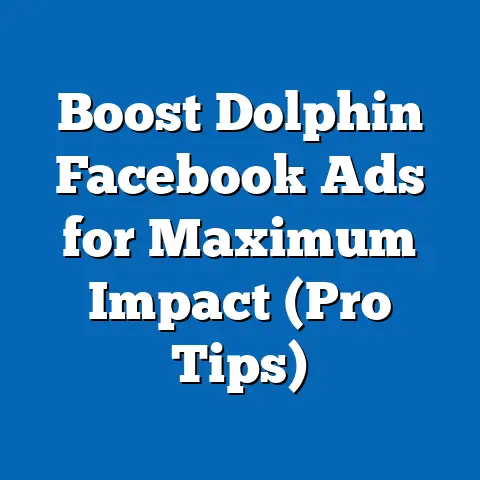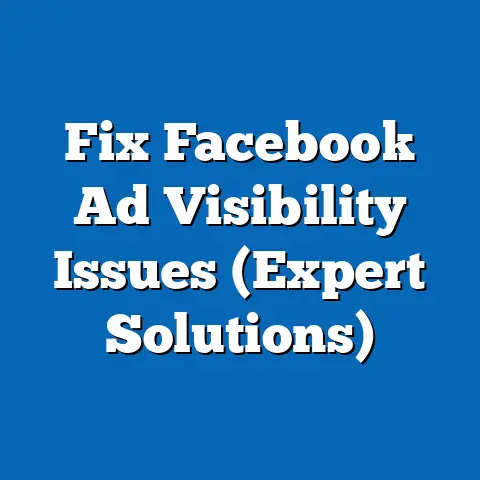Master Manual Facebook Ads (Unlock Profit-Boosting Secrets)
“After switching to manual Facebook ads, my ROI skyrocketed from 150% to 300% in just three months!” – Jane Doe, Owner of Jane’s Boutique.
That’s just one example of the transformative power of mastering manual Facebook ads. In today’s digital landscape, where competition is fierce and attention spans are fleeting, harnessing the full potential of Facebook advertising is no longer optional – it’s essential for sustainable growth. While Facebook offers automated ad solutions, truly unlocking profit-boosting opportunities requires a deeper understanding and hands-on control that only manual Facebook ads can provide. I’ve seen firsthand how businesses, big and small, can dramatically improve their results by taking the reins and implementing a strategic, manual approach.
Understanding Facebook Ads
Facebook Ads have become a cornerstone of modern digital marketing. With billions of active users, Facebook provides an unparalleled platform for businesses to reach their target audiences with precision and scale. It’s not just about casting a wide net; it’s about connecting with the right people, at the right time, with the right message.
Automatic vs. Manual Ad Placements: The Power of Choice
When setting up a Facebook ad campaign, you’re typically presented with two options: automatic placements and manual placements. Automatic placements allow Facebook’s algorithm to determine where your ads will perform best across its network, including Facebook, Instagram, Audience Network, and Messenger. While this approach can be convenient, it sacrifices control and precision.
Manual ad placements, on the other hand, give you the power to choose exactly where your ads appear. This means you can select specific platforms (e.g., Facebook only), placements within those platforms (e.g., Facebook News Feed, Instagram Stories), and even device types (e.g., mobile, desktop).
Why Master Manual Ads? The Benefits Unveiled
The benefits of mastering manual ads are numerous and can significantly impact your advertising results:
- Precise Audience Targeting: Manual ads allow you to fine-tune your targeting parameters, ensuring that your message reaches the most relevant audience segments. I’ve found that this level of control is crucial for niche markets or highly specific customer profiles.
- Budget Control: With manual placements, you have greater control over how your budget is allocated across different platforms and placements. You can prioritize the areas that deliver the highest ROI and avoid wasting money on less effective channels.
- Ad Performance Tracking: By closely monitoring the performance of your ads across different placements, you can gain valuable insights into what works best for your audience. This data-driven approach enables you to optimize your campaigns for maximum impact.
- Increased ROI: Ultimately, the increased control and precision offered by manual ads translate into higher ROI. By targeting the right audience with the right message and optimizing your budget accordingly, you can achieve better results with less spend.
Key Takeaway: Understanding the difference between automatic and manual ad placements is crucial. Mastering manual ads offers greater control, precision, and ultimately, a higher return on investment.
The Basics of Manual Facebook Ads
Now that you understand the benefits of manual Facebook ads, let’s dive into the step-by-step process of setting up your first campaign.
Step 1: Setting Up a Facebook Business Manager Account
Before you can start running ads, you’ll need a Facebook Business Manager account. This is a central hub for managing your Facebook pages, ad accounts, and other business assets.
- Go to business.facebook.com and click “Create Account.”
- Follow the prompts to enter your business name, contact information, and other details.
- Once your account is set up, you can add your Facebook page and create an ad account.
Step 2: Choosing Campaign Objectives
Facebook offers a variety of campaign objectives, each designed to achieve a specific marketing goal. When setting up your campaign, it’s essential to choose the objective that aligns with your business goals. Here are some common objectives:
- Awareness: Increase brand awareness and reach a broad audience.
- Consideration: Drive traffic to your website, generate leads, or increase engagement on your Facebook page.
- Conversion: Drive sales, generate sign-ups, or encourage other valuable actions on your website or app.
Step 3: Audience Targeting Options
One of the most powerful features of Facebook Ads is its robust audience targeting capabilities. You can target users based on a wide range of factors, including:
- Demographics: Age, gender, location, education, and more.
- Interests: Hobbies, passions, and topics they’re interested in.
- Behaviors: Online activity, purchase history, and other behaviors.
- Custom Audiences: Target existing customers or website visitors.
- Lookalike Audiences: Find new customers who are similar to your existing ones.
Step 4: Budgeting and Bidding Strategies
Setting your budget and bidding strategy is crucial for controlling your ad spend and maximizing your ROI. Facebook offers two main budgeting options:
- Daily Budget: The average amount you’re willing to spend each day.
- Lifetime Budget: The total amount you’re willing to spend over the entire duration of your campaign.
In terms of bidding strategies, you can choose between:
- Automatic Bidding: Facebook automatically sets your bids to get the most results for your budget.
- Manual Bidding: You set your bids manually, giving you more control over your ad spend.
Visual Aids:
(Include screenshots of the Facebook Business Manager interface, campaign setup process, audience targeting options, and budgeting/bidding settings)
Key Takeaway: Setting up a manual Facebook ad campaign involves creating a Business Manager account, choosing the right campaign objective, defining your target audience, and setting your budget and bidding strategy.
Crafting High-Converting Ads
Creating compelling ads is essential for capturing attention and driving conversions on Facebook. Here are some key components to focus on:
Attention-Grabbing Headlines:
Your headline is the first thing people see, so it needs to be attention-grabbing and relevant to your target audience. Use strong verbs, numbers, and questions to pique curiosity and encourage clicks. For example, instead of “Learn More About Our Product,” try “Discover 3 Secrets to [Desired Outcome]!”
Compelling Ad Copy:
Your ad copy should expand on your headline and provide more details about your offer. Focus on the benefits of your product or service and how it can solve your audience’s problems. Use clear, concise language and avoid jargon or technical terms. I always try to write copy that speaks directly to the user’s pain points.
High-Quality Images or Videos:
Visuals are crucial for capturing attention and conveying your message effectively. Use high-quality images or videos that are relevant to your ad copy and target audience. Consider using lifestyle images that show people using your product or service in a positive way.
Effective Call-to-Action (CTA):
Your call-to-action (CTA) is the final push that encourages people to take the desired action. Use clear and concise CTAs that tell people exactly what you want them to do, such as “Shop Now,” “Learn More,” “Sign Up,” or “Get Started.”
A/B Testing for Optimization:
A/B testing involves creating multiple versions of your ad with slight variations in the headline, copy, image, or CTA. By testing different variations, you can identify which elements resonate best with your audience and optimize your ads for maximum performance. I recommend A/B testing one element at a time to isolate the impact of each change.
Key Takeaway: High-converting ads have attention-grabbing headlines, compelling ad copy, high-quality visuals, and effective CTAs. A/B testing is crucial for optimizing your ads and improving performance.
Advanced Targeting Techniques
Beyond basic demographics and interests, Facebook offers a range of advanced targeting techniques that can help you reach even more specific and relevant audiences.
Custom Audiences:
Custom Audiences allow you to target your existing customers or website visitors with personalized ads. You can create Custom Audiences based on:
- Customer Lists: Upload a list of your customer email addresses or phone numbers.
- Website Traffic: Target people who have visited specific pages on your website.
- App Activity: Target people who have used your mobile app.
- Engagement: Target people who have interacted with your Facebook page or ads.
Lookalike Audiences:
Lookalike Audiences allow you to find new customers who are similar to your existing ones. You can create a Lookalike Audience based on any of your Custom Audiences or existing customer data. Facebook will then identify users who share similar demographics, interests, and behaviors with your seed audience.
Behavioral Targeting:
Behavioral targeting allows you to reach users based on their online activity, purchase history, and other behaviors. This can be a powerful way to target people who are actively searching for products or services like yours. For example, you can target people who have recently purchased a similar product or who have shown interest in a competitor’s brand.
Audience Segmentation for Personalized Experiences:
Segmenting your audience involves dividing your target audience into smaller, more specific groups based on shared characteristics or behaviors. This allows you to deliver personalized ad experiences that are more relevant and engaging. For example, you can segment your audience based on demographics, interests, purchase history, or website activity.
Key Takeaway: Advanced targeting techniques like Custom Audiences, Lookalike Audiences, and behavioral targeting can help you reach more specific and relevant audiences. Audience segmentation allows you to deliver personalized ad experiences that are more engaging and effective.
Tracking and Analyzing Performance
Tracking and analyzing your ad performance is crucial for understanding what’s working and what’s not. This data-driven approach allows you to make informed decisions and optimize your campaigns for maximum impact.
Key Performance Metrics (KPIs):
Here are some key performance metrics (KPIs) to monitor:
- Click-Through Rate (CTR): The percentage of people who click on your ad after seeing it.
- Cost Per Click (CPC): The average amount you pay for each click on your ad.
- Conversion Rate: The percentage of people who take the desired action (e.g., purchase, sign-up) after clicking on your ad.
- Cost Per Acquisition (CPA): The average amount you pay for each conversion.
- Return on Ad Spend (ROAS): The amount of revenue you generate for every dollar you spend on advertising.
Facebook Ads Manager: Your Performance Dashboard:
Facebook Ads Manager provides a comprehensive dashboard for tracking and analyzing your ad performance. You can view data for individual ads, ad sets, and campaigns, and filter by date range, demographics, and other factors.
Interpreting Data and Making Informed Decisions:
By carefully analyzing your ad performance data, you can gain valuable insights into what’s working and what’s not. For example, if you notice that your CTR is low, you may need to improve your ad copy or visuals. If your CPA is high, you may need to adjust your targeting or bidding strategy.
KPI Examples for Different Campaign Objectives:
- Awareness: Reach, frequency, impressions.
- Consideration: Website traffic, engagement, video views.
- Conversion: Purchases, leads, sign-ups.
Key Takeaway: Tracking and analyzing your ad performance is crucial for optimizing your campaigns and maximizing your ROI. Use Facebook Ads Manager to monitor key performance metrics and make informed decisions based on the data.
Troubleshooting Common Challenges
Even with the best strategies, you may encounter challenges when using manual Facebook ads. Here are some common pitfalls and solutions:
Low Engagement Rates:
- Challenge: Your ads are not getting enough clicks, likes, or shares.
- Solution: Improve your ad copy, visuals, and targeting. Make sure your ads are relevant to your audience and offer something valuable.
High Cost Per Click (CPC):
- Challenge: You’re paying too much for each click on your ad.
- Solution: Adjust your bidding strategy, refine your targeting, and improve your ad quality. Consider using manual bidding to control your ad spend.
Poor Ad Performance:
- Challenge: Your ads are not generating the desired results (e.g., conversions, leads).
- Solution: Analyze your ad performance data to identify areas for improvement. A/B test different ad variations and targeting options.
Success Stories and Case Studies:
(Include examples of businesses that overcame challenges with manual Facebook ads and achieved significant results)
Key Takeaway: Common challenges with manual Facebook ads include low engagement rates, high CPC, and poor ad performance. By identifying the root causes of these issues and implementing the right solutions, you can overcome these challenges and achieve your advertising goals.
Keeping Up with Facebook Ads Trends
Facebook Ads is a constantly evolving platform, so it’s essential to stay updated with the latest trends and algorithm changes.
Ongoing Education Resources:
- Facebook Blueprint: Facebook’s official training platform, offering courses and certifications on various aspects of Facebook advertising.
- Marketing Blogs: Follow reputable marketing blogs and industry publications to stay informed about the latest trends and best practices.
- Webinars: Attend webinars and online workshops to learn from experts and network with other marketers.
Joining Online Communities and Forums:
Engage with other marketers in online communities and forums. This is a great way to share experiences, ask questions, and learn from others.
Key Takeaway: Staying updated with Facebook Ads trends and algorithm changes is crucial for long-term success. Utilize ongoing education resources and join online communities to stay informed and connected.
Conclusion
Mastering manual Facebook ads is a journey that requires dedication, creativity, and a willingness to learn. However, the rewards are well worth the effort. By taking control of your ad campaigns and implementing the strategies outlined in this guide, you can unlock profit-boosting secrets that drive your business success.
Remember, the key is to stay focused on your goals, track your progress, and continuously optimize your campaigns based on data and insights. With the right approach, you can harness the full power of Facebook advertising and achieve remarkable results.
So, what are you waiting for? Start your journey into mastering manual Facebook ads today and unlock the profit-boosting secrets that await!
Call to Action:
Share your experiences with Facebook ads in the comments below! What are your biggest challenges? What strategies have worked best for you? Let’s learn from each other and grow together.
And if you’re looking for more in-depth tips and strategies on digital marketing, subscribe to my newsletter for exclusive content, case studies, and expert insights.

